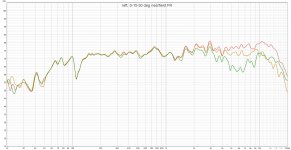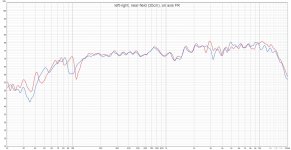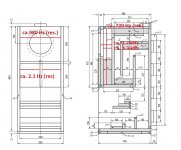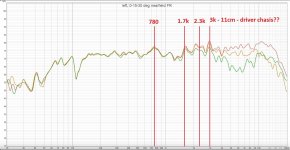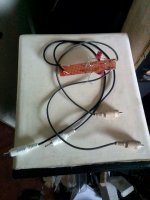I has gotten lonely here; but my interest in my own FE206E drivers/build has been reignited. Until I (possibly) start a thread for that build, I will come here.
I installed the whizzer/foam tweak. Listening to a single driver, with no coatings, about 20 degrees off-axis-it is really engaging; on axis is still pretty unlistenable. With my BLH (the odd one that includes an 8” PR on the compression chamber), upright string bass is really convincing with no other drivers. I also have paired it with a 15” u-frame open baffle sub with a plate amp, which adds most of the lower octave with nice integration---the driver has a sub-20hz fs and low sensitivity, but it has it's own amp and high power handling and excursion.
Phase plug experimentation will be next-I have a lathe and my choice of woods.
I wanted to share that I found another good way to do the $.98 foam tweak:
I used an approximately 15mm/9/16” slice of a tubular polyethylene pipe insulation “noodle”. I trimmed about half of the (inside) radial thickness from it. It ended up about 10mm (or 3/8”) thick radially. The diameter of the pipe insulation is about 55mm/2.25”, so two slices will be necessary to piece together around the approximately 75mm/3” whizzer.
Also, it is necessary to bevel back the inside of the radius, so that an approximately triangular cross-section is achieved. If a steep enough bevel is used only the front edge of the whizzer need make contact with the foam. I used a belt sander, upside down on a stand, contacting the round surface over the front roller, to make the bevel. Rough sandpaper, held curved in the hand, might accomplish the same thing.
Carefully work it in behind the whizzer. Use almost no force---the whizzer is very thin. If your foam does not fit---keep working on the foam---it is very cheap to do-over. By the way I don't think that a larger diameter pool noodle would work, it actually helps to have the “memory” of the smaller diameter shape to hug the circumference of the whizzer (off-color jokes not necessary). If one is careful, this tweak should be completely reversible.
I installed the whizzer/foam tweak. Listening to a single driver, with no coatings, about 20 degrees off-axis-it is really engaging; on axis is still pretty unlistenable. With my BLH (the odd one that includes an 8” PR on the compression chamber), upright string bass is really convincing with no other drivers. I also have paired it with a 15” u-frame open baffle sub with a plate amp, which adds most of the lower octave with nice integration---the driver has a sub-20hz fs and low sensitivity, but it has it's own amp and high power handling and excursion.
Phase plug experimentation will be next-I have a lathe and my choice of woods.
I wanted to share that I found another good way to do the $.98 foam tweak:
I used an approximately 15mm/9/16” slice of a tubular polyethylene pipe insulation “noodle”. I trimmed about half of the (inside) radial thickness from it. It ended up about 10mm (or 3/8”) thick radially. The diameter of the pipe insulation is about 55mm/2.25”, so two slices will be necessary to piece together around the approximately 75mm/3” whizzer.
Also, it is necessary to bevel back the inside of the radius, so that an approximately triangular cross-section is achieved. If a steep enough bevel is used only the front edge of the whizzer need make contact with the foam. I used a belt sander, upside down on a stand, contacting the round surface over the front roller, to make the bevel. Rough sandpaper, held curved in the hand, might accomplish the same thing.
Carefully work it in behind the whizzer. Use almost no force---the whizzer is very thin. If your foam does not fit---keep working on the foam---it is very cheap to do-over. By the way I don't think that a larger diameter pool noodle would work, it actually helps to have the “memory” of the smaller diameter shape to hug the circumference of the whizzer (off-color jokes not necessary). If one is careful, this tweak should be completely reversible.
I has gotten lonely here; but my interest in my own FE206E drivers/build has been reignited. Until I (possibly) start a thread for that build, I will come here.
Hey Howard, great to hear from you and your experiment! Life has been busy lately, but I am tinkering along as much as time permits. Heres my experiences.
Since, i've soldered together that BSC network properly (speaker level) and have mostly been just listening. I've made a little banana jumper/bypass so I could quickly compare with and without. I liked the new found bottom end, but than rather suddenlly I started to get bothered by the bass output of other systems and headphones. Seems like my preferance shifted or the maybe fostexes have trained me to hear more bass. Taking time to listen to some well produced material, I wasnt too crazy about the bsc anymore and have since removed it and instead im just using a -2db shelf from 2.5k onwards on Mojo's "lossless" (aledgedly) dsp.
My focus has now shifted towrds other mods discussed here, so thanks for your timely input on the foam mod🙂.
I have also done some more nearfield measurements and played with speaker position. They were set up roughly in a 3m triangle, with them firing directly into the room (roughly 30 deg off axis. I have since actually toed them in slightly to ca. 15 deg off axis, and found the trade off between extension of the highest frequencies and that peak around 2-3k favorable.
Nearfield measurements confirm this, past 15-20 deg or so, the highs get a little unpredictable. At 30 deg there is a wild dip from 3-7k and a peak at 10k. This i speculate could be due to the space between the whizzer and the membrane acting like a little horn amplifying those frequencies at that angle. This is where the foam mod could come in handy as well.
Also including L-R nearfield on axis, does it seem consistent to you?
All graphs are 1/12 smoothing, calibrated umik-1 mic.
Nearfield measurements confirm this, past 15-20 deg or so, the highs get a little unpredictable. At 30 deg there is a wild dip from 3-7k and a peak at 10k. This i speculate could be due to the space between the whizzer and the membrane acting like a little horn amplifying those frequencies at that angle. This is where the foam mod could come in handy as well.
Also including L-R nearfield on axis, does it seem consistent to you?
All graphs are 1/12 smoothing, calibrated umik-1 mic.
Attachments
I've experimented with babybelle cheese wax (that red stuff which is the bane of many mother's...) to dampen a steel speaker basket ( I jammed it in the gap near the magnet) and it seemed to work quite well, on other speakers I used a bit of foam between the magnet and an internal baffle. Pigs belly leather is soft and flexible, more so than 1/4 inch plus ox hide that I also use.
On some full range speakers I found the treble was lacking, after 2 initial efforts I succeeded in making an interconnect that reduced all frequencies via a resistor network, that was bypassed by small caps, to add some treble, it works really well; I did wonder of adding a 100k pot to make it ajustible and boosting the bass, but it's fine as it is.
On some full range speakers I found the treble was lacking, after 2 initial efforts I succeeded in making an interconnect that reduced all frequencies via a resistor network, that was bypassed by small caps, to add some treble, it works really well; I did wonder of adding a 100k pot to make it ajustible and boosting the bass, but it's fine as it is.
When you say interconnect, you mean a line level passive network? I'm thinking I should try Nelsons version down the line if all else fails. But that one is attenuating the highs, not boosting them. The FE206e👎 seems to work quite well at around 15-20 deg off axis, extending to 14-15k. That peak at 2-3k is the only thing that's still a bit hot, hopefully some of the physical mods will help.
Than there is that 700hz peak, which according to some of your fellas' reports shouldn't be there. Should be enclosure related,
I've plotted some reflection and resonant modes of the compression chamber against my nearfield measurement, The 780 HZ and 1.7-2.3kHz come up. Does this seem a likely, despite being completely stuffed with mineral wool? The 3kHz peak corresponds to ca 10-11 cm, could that be the driver chassis bounce (5cm 2 way)?
Than there is that 700hz peak, which according to some of your fellas' reports shouldn't be there. Should be enclosure related,
I've plotted some reflection and resonant modes of the compression chamber against my nearfield measurement, The 780 HZ and 1.7-2.3kHz come up. Does this seem a likely, despite being completely stuffed with mineral wool? The 3kHz peak corresponds to ca 10-11 cm, could that be the driver chassis bounce (5cm 2 way)?
Attachments
Last edited:
Yes, it's a line level passive network. I was first using a resistor network that fitted inside an rca plug in-between the DAC and a cheap class d amp that has a linear instead on log volume pot ("dolytec brease" or something) - the attenuation helped with controlling the volume at low levels, and since some speakers had falling off treble, I just thought that I'd bypass it with a cap. The third generation version won't fit in an rca plug, so I'll have to use a plastic box to house it in.
Bridger said: “Taking time to listen to some well produced material, I wasnt too crazy about the bsc anymore and have since removed it and instead im just using a -2db shelf from 2.5k onwards on Mojo's "lossless" (aledgedly) dsp”
Yes. It does seem like a well implemented active EQ, analog or digital, may often be preferable to passive components. Also passive components are not easy to implement well---I know this from the steep learning curve I have experienced in doing crossovers for multi-way speakers.
It seems that the “magic” of high-efficiency single driver speakers can be pretty easy to mess up. Despite their shortcomings, these drivers are likely designed by groups experts who have a deep wealth of historic precedent and combined experience to draw on. That said, many of the cone treatments and such that are done by DIYers, would be cost prohibitive at the price points where the less expensive Fostex drivers are offered.
Yes. It does seem like a well implemented active EQ, analog or digital, may often be preferable to passive components. Also passive components are not easy to implement well---I know this from the steep learning curve I have experienced in doing crossovers for multi-way speakers.
It seems that the “magic” of high-efficiency single driver speakers can be pretty easy to mess up. Despite their shortcomings, these drivers are likely designed by groups experts who have a deep wealth of historic precedent and combined experience to draw on. That said, many of the cone treatments and such that are done by DIYers, would be cost prohibitive at the price points where the less expensive Fostex drivers are offered.
cracked case said: Yes, it's a line level passive network. I was first using a resistor network that fitted inside an rca plug in-between the DAC and a cheap class d amp that has a linear instead on log volume pot ("dolytec brease" or something) - the attenuation helped with controlling the volume at low levels, and since some speakers had falling off treble, I just thought that I'd bypass it with a cap. The third generation version won't fit in an rca plug, so I'll have to use a plastic box to house it in.
Thank you for showing this. It seems like an elegant solution. I can imagine that it could be a more transparent solution than using passive components between the amplifier and the drivers.
When I have brought up this line level filter idea before, I have been reminded that the component values are dependent on the input impedance of the power amplifier (preamplifier also???) to create roll-offs at particular frequencies. This is similar to how the reactive components of a speaker crossover interact with the impedance of the system's drivers to create crossover points. Fortunately for the line level implementation, the power amplifier has a stable input impedance; while speaker drivers' impedance varies with frequency and drive level (and other factors???).
Thank you for showing this. It seems like an elegant solution. I can imagine that it could be a more transparent solution than using passive components between the amplifier and the drivers.
When I have brought up this line level filter idea before, I have been reminded that the component values are dependent on the input impedance of the power amplifier (preamplifier also???) to create roll-offs at particular frequencies. This is similar to how the reactive components of a speaker crossover interact with the impedance of the system's drivers to create crossover points. Fortunately for the line level implementation, the power amplifier has a stable input impedance; while speaker drivers' impedance varies with frequency and drive level (and other factors???).
bridger2086 said: "Nearfield measurements confirm this, past 15-20 deg or so, the highs get a little unpredictable. At 30 deg there is a wild dip from 3-7k and a peak at 10k. This i speculate could be due to the space between the whizzer and the membrane acting like a little horn amplifying those frequencies at that angle. This is where the foam mod could come in handy as well."
Do you have phase plugs in the drivers now?
I saw a picture of an 8" whizzer-cone Coral driver that had a ball, maybe the size of a golf ball, suspended in front of the whizzer, to act as some sort of wave guide, I suppose, maybe to help with dispersion.
If you think of the two cones as two separate drivers, one directly in front of the other, it is apparent that the pressure wave coming off the back of the front cone would be out of phase with the front facing wave coming off the rear cone---what could go wrong?
It seems likely that the foam is blocking some of both of those opposing waves, and is also damping the outside edge of the whizzer. Being un-terminated (in it's foam-less, stock, state), the outside edge of the whizzer may be resonating/ringing a bit wildly.
I understand that even cones that are terminated by surrounds sometimes benefit (largely in the mid-range) from additional damping materials being applied at the cone-surround junction. I believe that Dave says he puts Zig pen glue on the back side of the cone at the surround junction.
The foam also contacts the main cone in about the same spot as Planet 10's EnABL dots do on the FE206E, in pics that Dave has posted (where???). The dots are intended to lessen resonances in the cone. Maybe the foam would dampen those resonances too.
Do you have phase plugs in the drivers now?
I saw a picture of an 8" whizzer-cone Coral driver that had a ball, maybe the size of a golf ball, suspended in front of the whizzer, to act as some sort of wave guide, I suppose, maybe to help with dispersion.
If you think of the two cones as two separate drivers, one directly in front of the other, it is apparent that the pressure wave coming off the back of the front cone would be out of phase with the front facing wave coming off the rear cone---what could go wrong?
It seems likely that the foam is blocking some of both of those opposing waves, and is also damping the outside edge of the whizzer. Being un-terminated (in it's foam-less, stock, state), the outside edge of the whizzer may be resonating/ringing a bit wildly.
I understand that even cones that are terminated by surrounds sometimes benefit (largely in the mid-range) from additional damping materials being applied at the cone-surround junction. I believe that Dave says he puts Zig pen glue on the back side of the cone at the surround junction.
The foam also contacts the main cone in about the same spot as Planet 10's EnABL dots do on the FE206E, in pics that Dave has posted (where???). The dots are intended to lessen resonances in the cone. Maybe the foam would dampen those resonances too.
Last edited:
And here I was naively thinking those were just decoration 😀
Not using any whizer cones, wanted to try reversivle mods first, but i might try some improv elements to see what the effect is.
Not using any whizer cones, wanted to try reversivle mods first, but i might try some improv elements to see what the effect is.
I made a coat hanger wire bridge across the 206 frame and hot glued a ping pong ball about 1cm in front of the dust cap. Also put some dots of hot glue on the ball to lessen possible resonances. Seems to beam less intensely on axis, but the upper mids really are very strong still. They are most likely coming from the whizzer. I have not measured it, but hope to get around to doing so soon.
]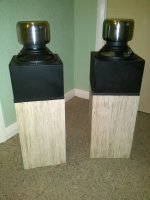
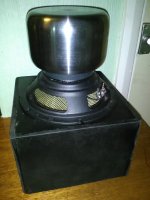
The thing about the Duevel Planets is that you're listening to reflected/diffused sound, if you want to have even dispersion and eliminate beaming, just stick the speaker driver inside out, so you're listening to the back of the cone.
The shiny lump is purely a weight to "anchor" the magnet. These is the speakers that I had to use the filter interconnect with, to get a decent treble response.


The thing about the Duevel Planets is that you're listening to reflected/diffused sound, if you want to have even dispersion and eliminate beaming, just stick the speaker driver inside out, so you're listening to the back of the cone.
The shiny lump is purely a weight to "anchor" the magnet. These is the speakers that I had to use the filter interconnect with, to get a decent treble response.
Last edited by a moderator:
Right Dave, those are omni-directional looking speakers.
The response off the back side of a di-pole must be similarly filtered as you have said about the inside out, upside down driver.
And my ping pong ball thing is close enough to the dust cap to be doing something a little different. Probably some characteristics similar to bullet phase plugs, but mostly blocking/redirecting the intense treble beaming of the FE206e.
The response off the back side of a di-pole must be similarly filtered as you have said about the inside out, upside down driver.
And my ping pong ball thing is close enough to the dust cap to be doing something a little different. Probably some characteristics similar to bullet phase plugs, but mostly blocking/redirecting the intense treble beaming of the FE206e.
Now I have a Faital Pro 10FE200 in 10”x10”x5” deep (internal) U-frame; this also has the corners filled in to make the square cross section into an octagon. The Faital is sitting on top of the 33” tall back horn at about seated head-height, with the FE206e about 3” below, frame to frame, about 12” center to center. A 10mH coil inline with the Faital, no filter on the 206. Because the 206 is lower, my head is about 10 degrees off axis.I made a coat hanger wire bridge across the 206 frame and hot glued a ping pong ball about 1cm in front of the dust cap. Also put some dots of hot glue on the ball to lessen possible resonances. Seems to beam less intensely on axis, but the upper mids really are very strong still. They are most likely coming from the whizzer. I have not measured it, but hope to get around to doing so soon.
Playing the integrated stereo amp in mono mode, one channel to each driver, balance slightly in favor of the Fostex. The slowly rolled off Faital does a great job of balancing the rising response of the 206. For an economical pro driver it has an acceptable smooth and lively sound for HIFI use.
Also have an OB u-frame 15” sub engaged for the last octave minus 10hz.
This combo plays well above the level it's monetary outlay would indicate. It reminds me of Hi-eff horn systems that I have heard. Chances are that the LP filter on the Faital could be more precise, but just balancing the FE206e spectrum response with a nice sounding OB hi-eff driver really is nice. We must remember though, that not all pro drivers work well in hifi systems, due to response irregularities and colorations. Also, of course, bigger drivers beam more. The 10FE200 is said to be(parts express)appropriate as a large format midrange.
Has anyone tried just filling the whizzer cone with a very pourous/nondense foam, or would that be way too much?
But im assuming the upper mids prominence is comming from the main cone and it transfering over to the whizzer?
But im assuming the upper mids prominence is comming from the main cone and it transfering over to the whizzer?
Significant weight would alter parameters, I just don't know what is "significant". I have read folks say that they lowered the sensitivity (including in the bass, I think) by adding substances to the cone. You could suspend the foam with an externally mounted armature, like I did with the ping pong ball. Of course you would not be physically damping the whizzer if it does not touch the foam.
Just as an intermezzo, has anyone had any experience with Sparkler Audio products? This "current-mode" amp looks interesting. Sparse information as one would expect from a boutique Japanese maker, can anyone expand on what this amp is? Is it a true transconductance amp?
http://sparkler-audio.com/portfolio/S502_en.html

http://sparkler-audio.com/portfolio/S502_en.html
- Home
- Loudspeakers
- Full Range
- Best Amp & cables for Fostex FE206En BLH
